Azumanga Daioh - Complete Collection
Introduction
Cue violins… I didn't have a conventional schooling. Actually it was conventional given the society in which I live, but there's something about being a child of immigrants in a multi-cultural school that adds a layer of difficulty and pressure to childhood. We all pride ourselves in being integrated and tolerant, celebrating our diversity, and united through common shared principles, regardless of culture. But the thing about kids is, they know nothing, and care less for all this. The first thing they see is difference, and that affects everything. Coming from a family of teachers, I was already isolated academically as I had been educated from day one. I was the weirdo in the corner reading, while everyone else in nursery was learning their ABCs. Cliques quickly developed, Indian kids stuck together (soon subdivided by religion), Vietnamese kids had their own group, and African kids were separate from the West Indians and so on. Of course there was integration, and everyone mixed, played and learnt together. But there was a ground state of likeness that everyone returned to. I longed for a 'normal' schooling, where I wasn't a minority statistic on a race relations form. You may be wondering about my frame of reference, but I've always had my parents' stories to go on. They went to school in Punjab, where the other students may have been Muslims, Hindus and Sikhs, but the bottom line was that they all looked similar to each other, and they all spoke the same language. Their school lives were golden, idyllic affairs, with large groups of friends, loads of fun and goofing around, coupled with a genuine joy in the experience. If there were any tension or conflict, it would be down to personality rather than cultural difference. It may not be politically correct, but frankly I'd rather be happy than satisfy the right thinking bean counters in my local council.
End violins… It wasn't that bad! The thing about culturally integrated schools is that they are harder work, but the rewards are worth it. After a couple of years of mutual hurts and scabbed feelings, you eventually learn about each other and begin to relate to each other as people, and school becomes a friendly and warm experience. That exposure to multi-culturalism stands people in good stead later in life as they enter the wide world. Also, what I remember fondly from school are my relationships with my teachers. Especially as I grew older, they stopped being authority figures, and I started seeing them as friends. Some teachers were inspirational, kind people who took an interest in me beyond just my exam grades. They were guides more than just teachers. I don't know how likely such relationships between students and teachers are now. When teachers aren't marking, or assessing, or filling in forms, their interactions with their students are legislated, scrutinised and monitored to the smallest degree. In a society where teachers have to watch for any inadvertent contact, lest a student files a complaint, I doubt that the friendships I had with my teachers are even possible anymore.
That's me, nostalgic for two golden ages of education that have long since past, one of which I never even experienced. Then one day, traipsing through the Interweb, I chanced upon a fansubbed episode of Azumanga Daioh. All of a sudden a golden haze and rose petals enveloped me. I was put in mind of the stories that my mum tells me about her school days, memories of friendships, hard work, silliness and nonsense. This was childhood as I wished it to be, pleasant, memorable and full of the warm fuzzies. As you can guess, a series boxset was soon winging its way to my door.
High School in Japan lasts just three years from age 15 to 17. It's a transitional period, when children become adults, where exams are sat, and where decisions are made that affect the rest of your life. Azumanga Daioh captures this period through the eyes of six friends at high school, with a series of vignettes, short four-minute sketches that make up the average 25-minute episode, and explore the memorable friendships that form between the girls. This is a show where the characters are more important than the premise, and along the way you'll meet: -
Chiyo: Chiyo Mihama is the child prodigy, the smartest in the class. She's also just ten years old, having skipped Middle School altogether and gone straight to high school with children 5 years older than her. She comes from a rich family, has a pet dog named Mr Tadakichi that is bigger than her, and is hard working and industrious. She's also short for her age, exceedingly cute with mobile pigtails, and a shoe-in for class mascot.
Osaka: Ayumu Kasuga is the other transfer student aside from Chiyo, but she's not too bright. She's from Osaka, which results in her nickname, as well as her accent. She's the most liable to be spaced out, in a dream world, or just asleep, but it's not a lack of intelligence, rather a skewed perspective on the world. Osaka can spend an entire lesson fixated on the bubbles in her eyes as they drift around the room.
Sakaki: She's athletic, she's smart, and she's exceedingly cool. She's also a little aloof and isolated. But that just masks Sakaki's inner self, someone who absolutely adores cute little kittens. It's a shame they don't return the sentiment. Sakaki is the sort of person who secretly find cute things adorable, in fact the slightest hint of cuteness tends to make her blush uncontrollably.
Tomo Takino: The loose cannon in the class. She may not be smart, or blessed with athletic ability, but she has boundless energy, and when she does something, she devotes 100% to it. Mostly it's spent on being boisterous and cheerful, and loud. She's been friends with Yomi since grade school, which infuriates Yomi no end.
Koyomi Mizuhara: Yomi is the Tomo's long-suffering best friend. She's smart and hard working, mature and level headed, and the most committed to succeeding in her education. Then Tomo comes and copies off her homework. Her greatest challenge in school is the reading on the bathroom scales.
Kagura: Kagura joins the class in the second year, and brings with it a genuine athletic talent and competitiveness. Sakaki is just naturally gifted, but Kagura works hard at her sports, and she's all ready to challenge Sakaki. It's just that she finds herself rivals with Tomo instead, competing in loudness and lack of academic ability.
Yukari Tanizaki: She's the homeroom teacher to the girls, specialising in English, although a more unconventional teacher you have never seen. She's more liable to be late than her students, she's brash, loud, self-centred (she's the adult version of Tomo), and has an arch rivalry with her best friend Nyamo, with whom she has been friends since they were both students at the same school. In fact, she nabbed Kagura from Nyamo's class when there was a lack of athletic ability among her students, and she has a bet with Nyamo each year over whose class will win at the sports' fest.
Minami Kurosawa: It may be infuriating for a teacher to be called by the diminutive 'Nyamo' in school, but then again Yukari has been Nyamo's best friend since they were both in high school. Now Nyamo is a PE teacher, and often finds herself the target of Yukari's competitive nature. But Nyamo is more level headed and sensible, more focussed and disciplined, although her family think that she should be married by now.
Two other characters to make note of are Kimura, the perverted literature teacher, who unashamedly tells his class that he became a teacher to see girls in swimsuits, and whose open mouthed appearances are enough to put the chills into any schoolgirl, and also Kaorin, member of the Astronomy Club and fellow class member who harbours an intense crush on Sakaki.
26 episodes are arranged across six discs.
Disc 1: Entrance!
1. Miss Yukari
2. Osaka's Day
3. Nyamo
4. Pool, Pool, Pool
5. Summer Break
Disc 2: Festivals!
6. Sports Fest
7. Culture Fest
8. New Year's Dream Special
9. Miss Sakaki
Disc 3: Rivals!
10. We're 2nd Year Students
11. Kagura and Sasaki
12. Chiyo-chan's Day
13. Exams
14. The Ocean, Summer Kimonos, And A Party!
Disc 4: Friends!
15. Sports Fest, 2nd Year
16. Culture Fest, 2nd Year
17. End Of 2nd Semester And Christmas
18. Koyomi's Ordeals
19. One Spring Night
Disc 5: Seniors!
20. 3rd Year
21. School Trip
22. Entrance Exams Study Camp
23. Last Sports Fest In High School
Disc 6: Graduation!
24. Yamamayaa
25. Onwards, Entrance Exams!
26. Graduation Ceremony
Picture
Azumanga Daioh gets a 4:3 regular transfer, which isn't the best I've ever seen. It's pretty clear and fairly sharp, the colours come across strongly, but the NTSC-PAL conversion issues do become strikingly apparent at times, with one pan particularly giving me double vision with the interlacing artefacts. More of a problem, and consistently apparent through the transfer is the aliasing. It's evident to some degree in almost every scene, little jagged edges to any diagonal line, and it can distract at times.
The look of the show is very special though. It's a gentle, nostalgic story that gets a gentle animation. Colours are all soothing pastels, while the character designs are simple and stylised. It's not the most vibrant of anime, there's no flash or CGI to the proceedings, and it does just enough to get the story and emotion across. For instance, when the teachers may be pontificating at the head of the class, the children will be represented as a white silhouette of massed heads, a sort of student cloud. But even with this simplicity, or perhaps because of it, Azumanga Daioh manages some truly poignant moments, little snippets of breathtaking beauty in amongst all the hilarity. There are moments of surrealism, as teenaged imaginations wander off in unprecedented directions, and it all works perfectly in telling the stories.
Sound
You have a choice between DD 5.1 English and German, DD 2.0 Japanese, along with translated subtitles and signs in both English and German again. My soundtrack of choice will always be the Japanese, but I decided to sample the English audio to knee-jerk a reaction for it. Actually, it isn't too bad, although I'm not a fan of 20 and 30-something actresses trying to sound half their age. It's a little too squeaky and forced for me. But generally the performances are acceptable enough. Azumanga Daioh gets a couple of whimsical but energetic themes, while the incidental music suits the gentle tone of the show perfectly.
My personal bugbear is the dub treatment of the Kansai accent and dialect. Listen to enough Japanese anime and you'll hear the difference in tone, inflection and vocabulary. Kansai to my ears sounds a little rawer and more sing-song in comparison to standard Japanese. There is also a difference in culture associated with the accents, much the same way that Scottish compares to English. Of course when it comes to dubbing the anime, you can't copy a foreign accent, and what anime companies usually do is substitute a familiar local English accent to get the same effect. Somewhere along the line, it became a standard for the Kansai accent to be dubbed with a Southern USA accent, y'all. It's not one of my favourite accents. Anyway, in the English dub, Osaka sounds as if she is from somewhere in Texas. It doesn't work at all well for me. Besides, when listening to the Japanese VA performance, the voice and the character are perfectly matched, just dreamy and cute. I couldn't imagine listening to her in any other way.
Extras
All six discs are presented in a foldout digipack, encased in a clear plastic slipcover. The disc blurb is printed on the plastic, which makes it a little hard to read against the digipack art. It also doesn't take kindly to being sat on by a postman as I have learned to my regret. The digipack folds out into four panels, with some nice character art on the reverse and behind the clear plastic disc holders, and the six discs are presented overlapping, two to a panel, although they are easy to remove. The fourth panel is foam covered, and holds the Chiyo pencil and notepad, and shame on you if you actually use either item!
Slipped in a pocket behind the first two discs is the 12-page series booklet. This contains the character profiles, three recipes, and two pages of translator notes.
The discs all are structured along the same lines. You'll find production sketch slideshow galleries featuring the main characters of the show as well as other characters and locations. Each disc gets the clean credit sequences, and spread across all six discs you'll find trailers for Magical Shopping Arcade Abenobashi, Kino's Journey, Full Metal Panic: Fumoffu, Neon Genesis Evangelion, Angelic Layer, E's Otherwise, Aquarian Age, Mahoromatic, and Full Metal Panic
What's different for this set is that the discs have been re-authored for the German market as well, and when you insert them, you'll have the choice of either language for the menus. The unlucky Germans have to put up with their equivalent of the 'You wouldn't prod a bard' anti-piracy trailer. You'll also find that the slideshow galleries are now annotated in German instead of English, and the German trailers get played instead of the UK ones. They're worth a look, as their Kino's Journey trailer is far more appropriate to the series than the English one, while the Evangelion trailer is longer and gets the full Beethoven.
Another difference is that the original discs had multi-angle credit sequences. These discs just play the original Japanese ones, but if you go into the DVD Credits menu in the extras, you'll find a 30 second German cast scroll, or in the UK menu, you'll find the English opening credit sequence, followed by all the ending credit sequences in English, put together as one 9 or 7 minute scroll depending on the number of episodes on the disc.
Disc 6 has the addition of the Azumanga Daioh Mini Movie. This was a 6-minute proof of concept that preceded the series. The animation is stronger, and it's presented in widescreen. It's machine gun paced, breathlessly fast, distilling around two episodes of gags into its brief run time.
There is also a mini-movie Character Gallery, and you can take a closer look at the differences between the series characters and their prototypes.
This is a sweet little package that stands out from the usual anime boxset. There's just one flaw though. The individual releases got a booklet each, with character bios and translation notes specific to that volume of episodes. The booklet we get here is just 12 pages in length, and the translation notes only take up a couple of those. That's a lot of translation notes that are left out, and it really does tell with some culture specific gags that tend to go over the head. It doesn't hurt the show though, as there is more than enough funny to take up the slack.
If you need all the funny, you can head over to this website, that has a wodge-load of translation notes.
http://azumanga.randomthunk.net/translatornotes.php
Conclusion
Azumanga Daioh is a hug. Not just any hug mind, but one of those fluffy, warm all-enveloping hugs that you'd get from your mum when you were three years old, smelling of cookies and ice-cream, the sort where you'd get lifted up like a feather, whirled around in a circle once and then gathered up into a heavenly bubble of love and happiness and breathless joy, and you'd giggle uncontrollably, because you knew it would last forever. The creators of Azumanga Daioh have distilled that feeling, and somehow transcribed that warm embrace onto six shiny pieces of plastic.
You've probably guessed by now that Azumanga Daioh holds a special place in my heart. It's a little surprising I guess, considering that anime set in high school are two a penny, and your average anime protagonist is of school age. But Azumanga Daioh is refreshingly absent of the standard high school anime clichés. There are no teen romances for one thing, there's no angst, no fighting tournaments taking place, no secret alien infiltration, and no one, but no one climbs into a 150 ft mecha on a regular basis. Azumanga Daioh is about friendship pure and simple, as it follows the lives of six girls in particular as they make their way through three years of high school together. There's no over arching plot either, no major storyline to resolve, and the way that the show is structured, consisting of brief four-minute skits means that the primary focus is on comedy, and the character development that does occur happens it seems by happy coincidence. The gags come first, and the fact that you wind up caring about these characters is almost accidental.
The short skit format could have been a little random, but it's helped by the fact that the scenes usually revolve around a common theme for each episode, and for certain episodes there is a greater sense of continuity between the sketches than the others. The structure for the show comes from the academic year, and as we follow the school lives of the characters, certain events crop up with a degree of regularity, whether it's the changing of the seasons, or the regular sports and culture festivals, or the girls' annual summer trips together. It also helps that we get a rounded picture of school life, as two of the main characters are teachers rather than students, and there's no sense of us versus them that you usually get from school anime (or the usual complete absence of the faculty altogether). In fact the show starts by introducing Miss Yukari, who will turn out to be the girls' homeroom teacher for the next three years, and we instantly get the sense with her level of maturity that she is barely out of school herself. We are also introduced to her best friend and fellow teacher Nyamo, and they both turn out to be as much friends as they are guides and mentors to their students, as well as a questionable example in Yukari's case.
Of course there has to be the one teacher that tries too hard to be in with the kids, and just comes off as creepy as a result. Kimura is the one without social skills, and whose attitude to female students would be ringing alarm bells in schools the world over. Of course it's all innocent and meaningless. In a show like Azumanga Daioh it can't be anything other than that. He's just the odd teacher that's in every school, the one that wears corduroy jackets, smells just a little odd, and says completely the wrong thing when he tries to interact with students outside of the academic context.
It's the students that are at the heart of the show, and while it is easy, and inevitable to pick favourites, there is something inherently likeable about every character in the show. Personally I feel that everyone needs a little Osaka in their lives, she's the dreamiest, sweetest space cadet around, and her tilted view of the world makes for some great comedy moments. It helps that her Japanese voice is just so quirky and unique, but the flights of fancy that her mind takes make for some of the more surreal moments of the show. Wondering if Chiyo's pigtails are detachable is just the start. She's also the kind of person who if she finds a phrase that she likes the sound of, she just won't let go of it, immediately apparent on the class trip to Okinawa, where 'Champloo' and 'Sata Andagi' become odd catchphrases. She's also the master of lateral thinking, and although her questions may not have any easy answers, they always get people scratching their heads. She's also the only person who can turn flatulence into a ghost story.
Sakaki is adorable for other reasons, she's the tall, quiet introverted one, who does well in class, and is naturally gifted at sports. Her aloof demeanour and elegance make her the coolest girl in class, and she's idolised by Kaorin, who has one of those intense teenage platonic crushes on her. But that inapproachability masks someone who is absolutely goofy about cuteness. She melts in the presence of cute, sweet things, especially cute furry things like kittens and puppies. It's almost tragic that her family can't tolerate cats, and brutally ironic that cats don't tolerate her. Her repeated attempt to pet the neighbourhood moggy invariably results in bandages for her fingers. She's blushing overtime when Chiyo starts in the same class as her, a ten-year-old girl in pigtails is almost too much for her, especially when she meets Chiyo's oversized dog Tadakichi. In another early surreal departure, she imagines Chiyo's father to be a talking cat, and oddly enough, Chiyo's feline father becomes the show's mascot, showing up more than once. I find the idea of a tall, elegant girl turning bright red at even the thought of kittens incredibly cute.
Cuter even than Chiyo-chan, the class's ten-year-old prodigy. Chiyo's skipped ahead in her education five years, and initially looks completely out of place in high school, although mostly it's because she's the smartest in the class, smarter even than Miss Yukari on occasion. But there's no getting around the fact that she's hardly four feet tall, incredibly sweet, and most of the girls in the class take to her like she's their doll. She becomes class representative, and takes on the responsibilities that entails, but there's no getting around the fact that she's ten, and reacts as a ten-year-old would. She's a ripe target for teasing, and she's always worried that she's out of place, especially when Sports Fest comes around, and she has to compete with girls twice her size. Somehow Chiyo manages to be sweet and cute, without becoming cloying and excessive.
Chiyo is a prime target for Tomo, who is the class tomboy. She's loud, brash and energetic, which would be useful is she was smart. She's not smart. Whatever she does, she gives it her all; it's just that she rarely focuses her attention on anything useful or productive. She's there to infuriate and annoy, like Osaka, she can pick up a phrase and repeat it ad nauseum, but she always picks on the rude phrases guaranteed to get under the skin of her best friend Yomi. The fact that she's in this prestigious high school is because she wanted to annoy Yomi. A few days before the entrance exams, she decided to revise like crazy, and wound up passing the test. She's evidently aiming to do the same again in high school, so she tends to loaf while those around her work hard.
Yomi is the voice of reason in the class, certainly the most mature, and the most likely to keep her friends' feet on the ground when they threaten to drift off on pointless diversions. She has a world-weariness that belongs to someone a good deal older, and a lot of that comes from her friendship with Tomo, whose immaturity cancels out her own level-headedness at times. But Yomi too has a sweet whimsical side, and although it is rarely seen, it's all the more appreciated when it is. Her karaoke skills are a little lacking though.
Kagura comes a little late to the group, but she's the more interesting addition, as in some ways she's a combination of the other girls. She's a more committed athlete than Sakaki, she actually works at it, but in terms of intelligence, she's more on the level of Osaka and Tomo, but she has some of Yomi's levelheaded nature and pragmatism too. She wants to compete with Sakaki, but she is tomboy enough to attract the attentions of Tomo, and they wind up competing in the idiocy stakes. What's interesting is that her character shows the most growth during the series. As she comes to the class in the second year, it takes a little while for her to integrate with the group, and she sort of becomes our eyes on the friends. Watching her learn from everyone else is fascinating, and the difference in character from when she started the class to the end of the series is more measurable in her than in the other girls.
You'll notice that I didn't go into too much detail about what happens in the show. Two reasons for that mainly, one is that there is just so much good stuff that commenting on one moment invariably leads to ten others, and this will turn into a significantly longer review. The other thing is that this is a show that definitely has to be experienced for yourself, and spoilers aren't appreciated. But the warm glow that this show gives you is indescribable, and its sweet, gentle character comedy leaves you feeling infinitely better about the world. The only problem with that is the palpable sadness and sense of loss when the show comes to an end and you have to take the sixth and final disc out. It's a melancholy that can only be alleviated by putting disc one into the player and watching it all over again. Azumanga Daioh is a feel-good anime without peer. It's the reason DVD players were invented.

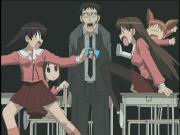

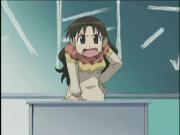
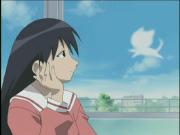
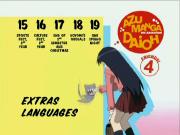
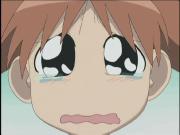
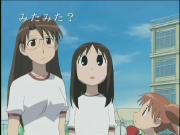
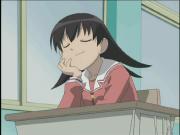
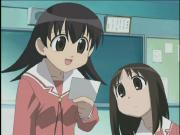


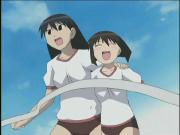
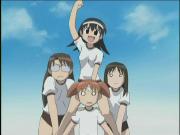

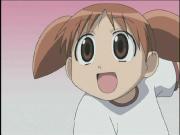
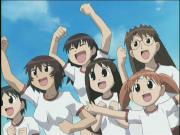
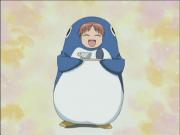
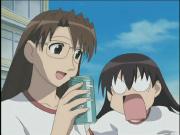

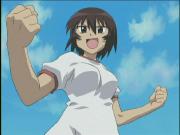
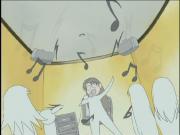
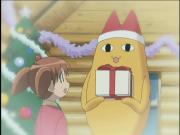
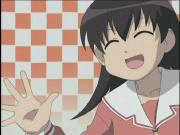
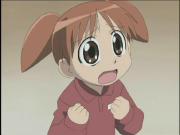
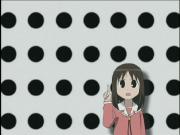
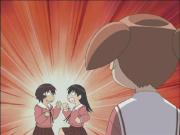
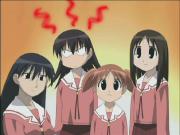

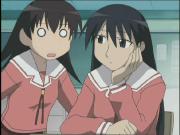
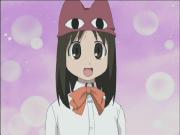

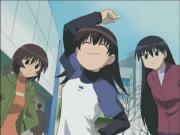
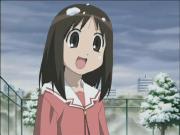
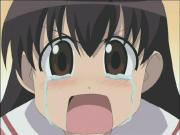
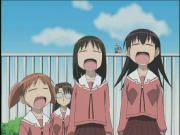
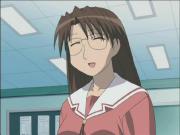

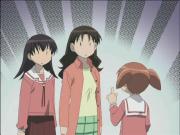

































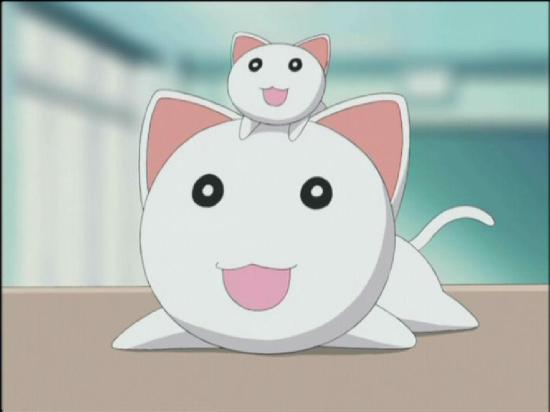







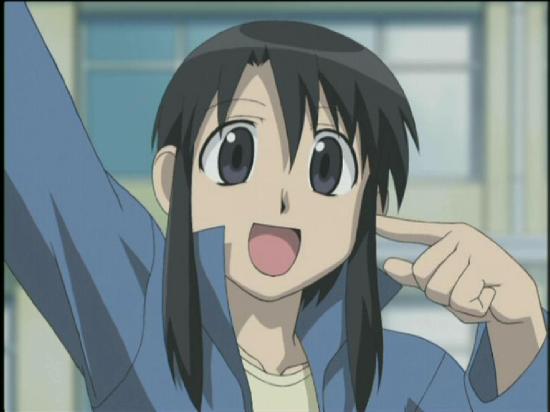


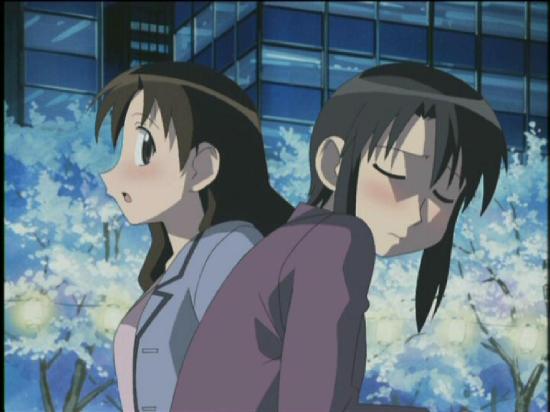






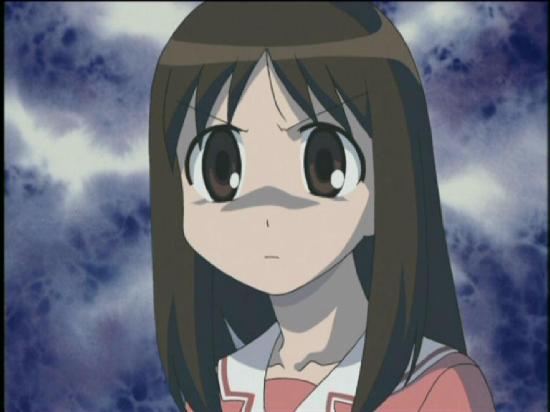





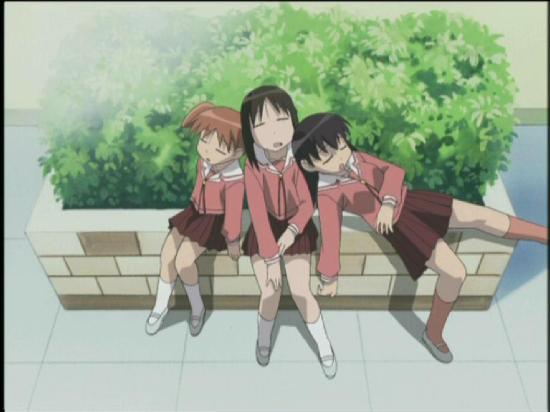
Your Opinions and Comments
Be the first to post a comment!